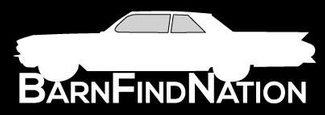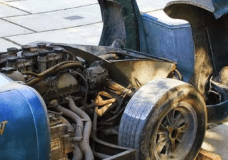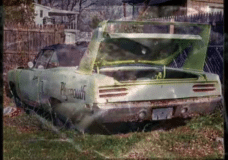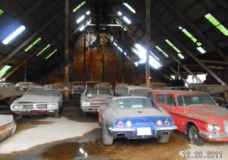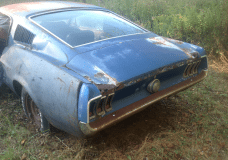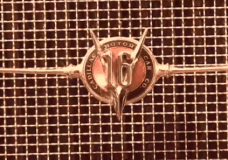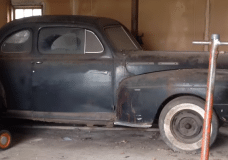1965 Chevelle Nomad Barn Find
Now this is a rare find
This 1965 Chevelle, non-Nomad Barn Find is a bit more than a little rusty from the initial look at it. I have seen much worse restored however and this Nomad Wagon being a Chevelle is worth restoring in my eyes!

The Chevrolet Nomad was a station wagon style model made off and on from 1955 to 1972. So if there was a 1971 model year of it then I want that one in particular as my first registered street vehicle was a 1971 Big Block 4 speed Chevelle.

Seeing as the ’71 model might be wishful thinking I still love pretty much all of the Nomads out there.


Thanks to Wikipedia for the information on all the years of Nomads produced starting in 1955-
1955–1957
First generation
1955-chevy-nomad-chevrolet-archives.jpg
Overview
Production 1955–1957
Body and chassis
Body style 2-door/2-bench seats station wagon(1955–1957)
Platform A-body
Powertrain
Engine 265 cu in (4.3 L) V8
283 cu in (4.6 L) V8
Dimensions
Wheelbase 115 in (2,921.0 mm)
Length 201 in (5,105.4 mm)[1]
1955 Chevrolets received all-new styling. Advertised as “The Hot One,” the boxy new Chevy was crisp, clean, and thoroughly modern-looking. Nomads, like Bel Airs, came loaded with interior carpet, chrome spears on front fenders, chrome window moldings, and full wheel covers. For 1955 Chevrolets gained a V8 engine option. The new 265 cubic inches (4,343 cc) cubic-inch V8 featured a modern, overhead valve high compression, short stroke design that was so good that it remained in production in various forms, for many decades. The base V8 had a two-barrel carburetor and was rated at 162 horsepower (121 kW), and the “Power Pack” option featured a four-barrel carburetor and other upgrades yielding 180 brake horsepower (130 kW). Later in the year, a “Super Power Pack” option added high-compression and a further 15 brake horsepower (11 kW). It had room for six passengers.[2]
1956 Chevrolets received a face-lift. This gave Chevys a more conventional full-width grille, pleasing those customers who didn’t like the Ferrari-inspired ’55 front end. Nomads now carried the same interior and rear-wheel sheetmetal as other Bel Airs, lacking the original’s unique trim. Shoulder harnesses, and a padded dashboard were now available. For 1956 Chevys hid the gas cap behind a left side, flip-down tail light.
1957 V-8 engine displacement grew to 283 cubic inches (4,638 cc) from 265 in 1957, with the “Super Turbo Fire V8” option producing 283 horsepower (211 kW) with the help of continuous fuel injection. These so-called “fuelie” cars are quite rare, since most Bel Airs were fitted with carburation. While considered to be a milestone vehicle design, General Motors discontinued the original Nomad Sport Wagon at the end of the 1957 model year due to low sales and the introduction of a new body for 1958.
Next they went to the Full Size Platform
1958–1961
Second generation
1960 Chevrolet Nomad.jpg
Overview
Production 1958–1961
Body and chassis
Body style 4-door/5-seat station wagon
Platform GM B platform
Powertrain
Engine 265 cu in (4.3 L) V8
283 cu in (4.6 L) V8
1958 For the 1958 model year, Chevrolet moved the Nomad name to its top-line four-door Bel Air based station wagon,[3] right above the new mid-priced Biscayne based Brookwood. This was the only four-door Bel Air based Nomad station wagon. Like the rest of Chevrolet’s 1958 full size car line up, the Nomad featured Chevrolet’s new “Safety-Girder” cruciform frame. Similar in layout to the frame adopted for the 1957 Cadillac, it featured box-section side rails and a boxed front cross member that bowed under the engine, these “x-frames” were used on other 1958 to 1964 Chevys, as well as Cadillac. The rear was tied together by a channel-section cross member. [4]
1959 In 1959, the Nomad was transferred from the Bel Air to the expanded Impala model range, which had been the top-line Chevrolet Bel Air two-door the previous year and had now became a separate model that included four doors. Nomad, still at the top was a six-passenger car. The other 1959 Chevrolet station wagons were the new Kingswood four-door nine passenger, the new Parkwood four-door six passenger, the new Brookwood two-door six passenger, and Brookwood four-door six Passenger. With the Delray gone, the Biscayne based Brookwood, was now priced lowest. The Brookwood two-door marked the short lived return of the two-door wagon and was the basis for the new-for-1959 El Camino. Unlike the Brookwood, the El Camino could be ordered in trim levels corresponding to the entire full-sized car line including the Impala.
1960 For 1960, the Impala based Nomad four-door was revised with more conventional styling. The Kingswood and the two-door Brookwood were dropped at the end of the year along with the El Camino.
1961 In 1961, all full-size Chevrolets were restyled on the existing GM B platform. The new body styling was more trim and boxy than the 1958-60 models. Chevrolet continued to use the Nomad name until the end of the 1961 model year, when all Chevrolet station wagons adopted the names of the regular sedan models for 1962. The Nomad had body-on-frame construction, using the “X” frame to the end.
Almost the last year of production gave us these models-
1968–1972
Main article: Chevrolet Chevelle
Third generation
1969 Chevrolet Chevelle Nomad.jpg
Overview
Production 1968–1972
Body and chassis
Body style 4-door/5-seat station wagon
Platform GM A platform (RWD)
Between 1968 and 1972 the names Nomad and Nomad Custom were applied to the lowest-priced Chevelle four-door station wagon model, below the Chevelle Greenbrier, Chevelle Concours, and Chevelle Concours Estate.
1968 For 1968, Chevelle got a new body style (though still under the 817 and 817 internal designations)[5] emphasized the “Coke bottle” look even more. New Federal safety-mandated equipment included side marker lights on each fender, as well as shoulder belts for outboard front-seat occupants on cars built after December 1, 1967. This explains why some ’68s had shoulder belts, and some early-production cars did not. However, all ’68s had anchors for the belts. Manual transmission cars got GM’s “Air Injection Reactor (A.I.R)” smog pump, which added complexity under the hood.
1969 By 1969, each Chevrolet station wagon regained its own unique model name. All ’69 Chevelles also got a new locking steering column, one year ahead of the Federal requirement. Headrests, required for all cars sold in the U.S. after January 1, 1969, were installed on all ’69 GM cars.
1970 The 1970 Chevelle Nomad had even more restyling. Each head lamp was put in its own chrome housing and was no longer integrating into the grille. The body lines were less swept and a new integrated rear bumper was used.
1971 For 1971, all Chevelles got two big headlights in place of the quads, and GM mandated all divisions design their engines to run on lower-octane regular, low-lead or unleaded gasoline due to tightening emission requirements and in anticipation of the catalytic converter that would be used on 1975 and later models, necessitating the use of unleaded fuel. To permit usage of the lower-octane fuels, all engines featured low compression ratios (9:1 and lower; well below the 10.25-11.25:1 range on high-performance engines of 1970 and earlier).
1972 The last Nomad station wagon ended with the end of the first-generation Chevelle at the end of the 1972 model year.
Lastly, we have on of the models that I did actually own but, never got it finished so I sold it no engine as it used to be a V8 swap-
1976 Chevy Vega wagon Nomad package
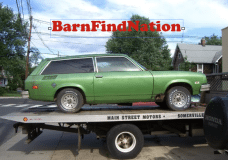
In 1976, special Vega Nomad wagons were assembled with unique side window trim and filler panels (to make the ‘b’ pillars appear forward-slanted), tailgate rub strips, vinyl Nomad script identification.
